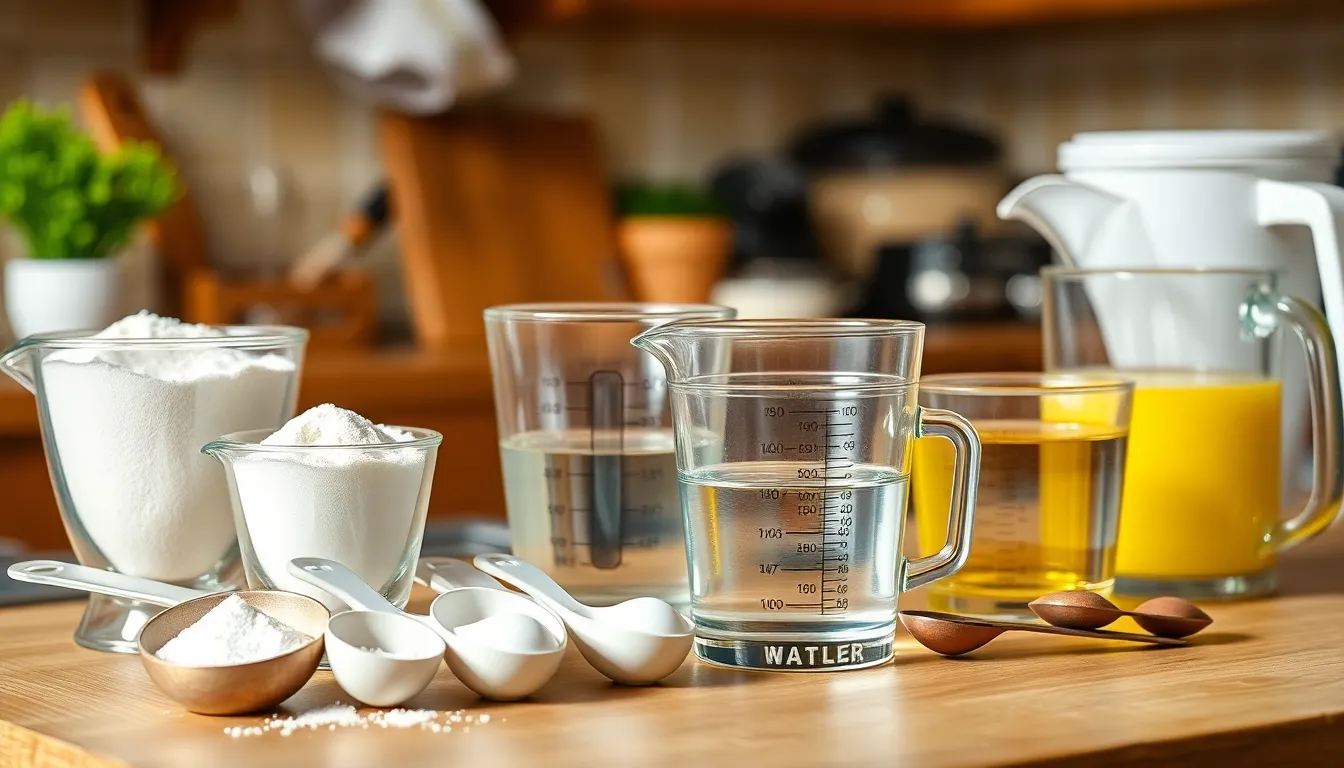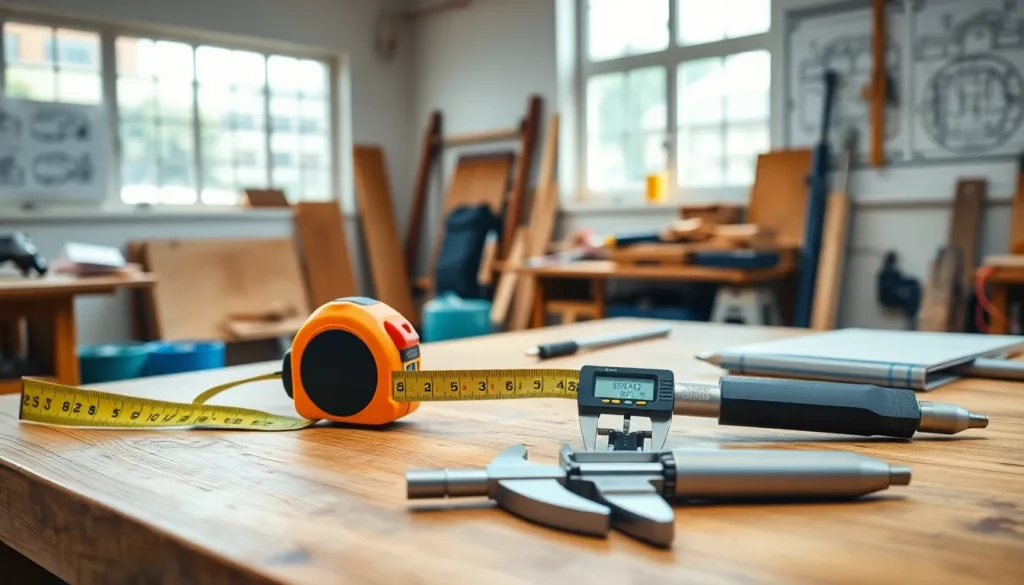In the culinary world, precision is the secret ingredient that transforms a good dish into a great one. Without the right measuring tools, even the most experienced chefs can find themselves in a pickle—or worse, a bland stew. From the humble measuring cup to the high-tech digital scale, these tools are the unsung heroes of the kitchen, ensuring that every pinch and dash is just right.
Imagine whipping up a soufflé only to discover you’ve added a cup of sugar instead of a tablespoon. Yikes! That’s a sweet disaster waiting to happen. With the right measuring tools by their side, home cooks can confidently tackle any recipe, knowing they’re on the path to culinary success. So let’s dive into the world of measuring tools and discover how they can elevate your cooking game while keeping the kitchen chaos at bay.
Table of Contents
ToggleOverview of Measuring Tools in Kitchen
Measuring tools play a crucial role in achieving success in the kitchen. Common items include measuring cups, measuring spoons, and kitchen scales, each serving a specific purpose in food preparation. Accurate measurements ensure consistency in recipes, enabling home cooks to replicate dishes successfully.
Measuring cups typically come in sets with various sizes, such as 1 cup, ½ cup, and ¼ cup. These cups are essential for liquid ingredients, allowing for precise portions. Likewise, measuring spoons, usually ranging from 1 tablespoon to 1 teaspoon, offer the same level of accuracy for small quantities.
Digital kitchen scales have gained popularity due to their reliability and ease of use. These scales provide measurements in grams, ounces, or pounds, catering to various cooking and baking needs. Ultimately, weighing ingredients can yield better results, especially in baking, where precision is paramount.
Liquid measuring cups, with their spouts and markings, help eliminate spillage during pouring. Some models even feature clear measurements on the sides, allowing cooks to check liquid levels accurately. Comparatively, dry measuring cups lack a spout but are designed to hold dry ingredients such as flour and sugar.
Accuracy in measuring directly influences dish quality. Inconsistent measurements often lead to culinary mishaps, like a poorly risen soufflé or a burnt cake. Thus, utilizing the correct measuring tools simplifies the cooking process, building confidence in home cooks while minimizing potential kitchen chaos.
Types of Measuring Tools

Measuring tools play a crucial role in achieving precise recipes. Different types offer unique functionalities suited for various ingredients.
Dry Measuring Tools
Dry measuring tools include measuring cups and spoons designed for ingredients like flour, sugar, and spices. Standard cups usually come in sizes such as 1 cup, 1/2 cup, and 1/3 cup, allowing for easy scaling of recipes. Accurate scooping and leveling ensure consistent measurements. Measuring spoons often range from 1 tablespoon to 1/4 teaspoon, providing versatility for smaller quantities. It’s essential to use dry measuring cups for dry ingredients to avoid inaccuracies that liquid containers may introduce.
Liquid Measuring Tools
Liquid measuring tools are specifically designed for liquids like water, oil, and milk. Glass or plastic measuring cups typically feature clear measurement markings, aiding in precise pouring. Standard sizes often include 1 cup, 2 cups, and larger options like 4 cups, accommodating various liquid amounts. Additionally, measuring jugs may have spouts for easy pouring and reduced spills. Using a specific liquid measuring cup guarantees accuracy when measuring smaller amounts or large quantities, promoting overall recipe success.
Importance of Accurate Measurements
Accurate measurements play a crucial role in cooking success. They influence the overall outcome of recipes and ensure consistent results.
Impact on Recipe Outcomes
Precision in measuring ingredients directly affects the taste and texture of dishes. Just a slight variation in ingredient quantities can alter flavors dramatically. For example, adding too much flour can lead to dry bread, while not enough can result in a mushy loaf. Successful baking relies on exact ratios, as chemical reactions during the process are sensitive to measurement changes. Culinary experts emphasize that even seasoned cooks benefit from strict adherence to measurements, reinforcing their importance in achieving desired results.
Consistency in Cooking
Consistency relies heavily on accurate measurements. Reproducing a favorite recipe successfully requires exact ingredient amounts every time. Variations can confuse cooks and create discouragement, especially for beginners. Measuring tools provide a standard, allowing home cooks to repeat their successes. By using the same measuring cups and spoons, everyone can achieve reliable results in the kitchen. Following prescribed measurements also fosters confidence, which is essential for experimenting with new dishes.
Tips for Choosing Measuring Tools
Selecting the right measuring tools enhances cooking accuracy and overall results. Knowing what to consider simplifies the process.
Material Considerations
Choose measuring tools based on material for optimal performance. Stainless steel offers durability and resistance to rust, ideal for both dry and liquid ingredients. Glass measuring cups provide clear visibility of measurements, allowing for precise pouring and easy cleaning. Plastic tools, while lightweight and often more affordable, may warp over time or stain with certain ingredients. Silicone measuring tools offer flexibility and easy release of sticky substances. Proper material selection impacts longevity and usability, promoting a more efficient cooking experience.
Design and Usability
Evaluate the design and usability of measuring tools for ease of use. Ergonomic handles help with gripping and pouring, making the measuring process more comfortable. Consider graduated markings that are easy to read at a glance, ensuring accuracy when measuring ingredients. Some tools feature pour spouts to prevent spills when transferring liquids. Additionally, stackable measuring cups save space in storage, promoting organization. The right design enhances efficiency in the kitchen, making cooking a more enjoyable task.
Choosing the right measuring tools is essential for anyone looking to elevate their cooking game. With the right instruments in hand, home cooks can achieve the precision needed for consistent and delicious results. Whether it’s dry or liquid measurements accuracy plays a pivotal role in the quality of dishes. Investing in durable and user-friendly measuring tools not only simplifies the cooking process but also boosts confidence in the kitchen. By understanding the importance of measurement and selecting the appropriate tools, anyone can turn cooking from a chore into a delightful experience.










